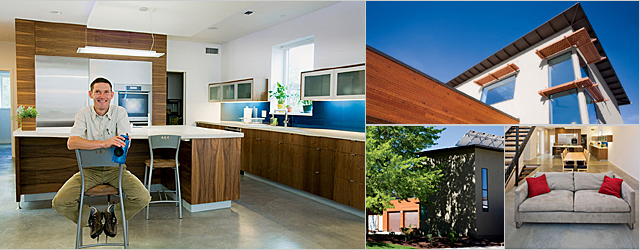sierraclub.org - sierra magazine - september/october 2010 - comfort zone
Aggressively Passive
By Jasen Lee

Architect Dave Brach with his concrete countertops and floors, which add to the Breezeway House's energy-storing thermal mass; solar shading graces the windows; hyper-attention to energy use makes the house hyper-comfortable; a shady maple and a photovoltaic system boost efficiency.| Nicole Morgenthau (left and below left); courtesy of Jeremy Wold/Brach Design (above and below right)
""The glazed concrete floor never gets cold," says home owner Joe Turner. "So we can walk on it barefoot."
Of the intricate energy and temperature control system, Turner says, "If something goes wrong, it could be a challenge to pick up on it and get it fixed."
Joe Turner relies on his body heat to warm his Salt Lake City house in winter. But that's not because he's chintzy when it comes to utility bills.
The first certified "passive house" in the western United States, Turner's thick-walled, superinsulated, airtight Breezeway House is heated primarily by passive solar gain and by the people and everyday appliances and electrical equipment inside it. The house uses about 90 percent less energy than an average existing home and about 80 percent less energy than an average newly built home.
Passive-solar buildings take advantage of the sun's daily and seasonal cycles and maintain interior thermal comfort by using a heat exchanger instead of a furnace and an air conditioner. "You don't cool the house," says David Brach, the home's architect. "You keep it from getting hot."
The difference between a certified passive house and one with the highest-level LEED certification is that the passive house focuses exclusively on energy efficiency. "A LEED Platinum house has to meet a certain level of energy efficiency, but it doesn't have to get anywhere near a passive house," Brach says.
Efficiency triumphs aside, the Breezeway House is cozy. "The comfort level is second to none," Turner says. "It's always the same temperature inside. You don't get warm, you don't get chills, and there are no drafts."
But cozy doesn't mean claustrophobic when you have three bedrooms, two baths, and 2,800 square feet of living space. Turner and partner Rebecca Guymon wanted a spacious double-height living room, which added to the challenge, because certification by the Passive House Institute United States is based partly on energy used per square foot.
About 75 percent of the home's remaining energy needs are met by a photovoltaic system and solar thermal panels. In summer, Turner sells power back to the utility; in winter, his utility bills are between $10 and $50 per month—giving him a new appreciation for simple body heat.
ON THE WEB What's your idea of a green living or work space?
Tell us at sierraclub.org/sierra/shelter.